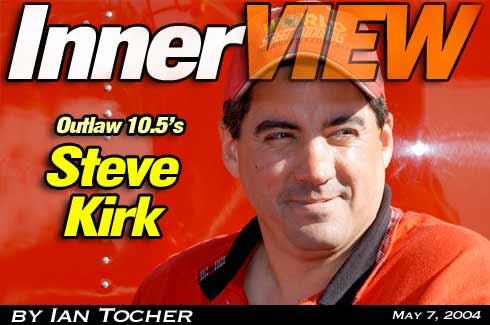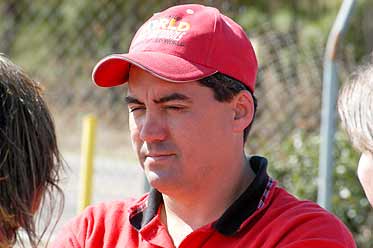
![]() teve
Kirk is of the new breed of Outlaw 10.5 racers. He shows up with a major-league
racecar hauler, his 2000 Camaro carries only the best of everything, his uniformed
team presents a professional image to the fans, and he backs it all up with
stout on-track performances.
teve
Kirk is of the new breed of Outlaw 10.5 racers. He shows up with a major-league
racecar hauler, his 2000 Camaro carries only the best of everything, his uniformed
team presents a professional image to the fans, and he backs it all up with
stout on-track performances.
Kirk actually began his race-driving career as a roundy-rounder in dirt late-models back in 1984, but made the permanent switch to straight-line action in 1988. He has previously competed in Pro Stock, Pro Street, and Pro Mod, but the Monroe, GA-based driver seems to have found his niche amongst the outlaws. In March, he sat down with DRO at the Outlaw Racing Street Car Association’s season opener at Jackson, SC, to give his inner view of the class.
DRO: How did you get started in Outlaw 10.5 racing?
Kirk: Around ‘95 and ‘96, the 10-inch tire stuff started coming around really good and we actually had the first Outlaw 10.5 car that would go in the sevens in the quarter mile. We won numerous events, local races, in those years.
Then I went Pro Street racing with NMCA in 1998 and campaigned a ‘69 Camaro for a year and a half. I think we still hold the world record for a Pro Street automatic car, which was 6.88 at 207 mile an hour. After the ‘99 deal we helped Macon put on a big 10.5 race and that’s what really got this deal initiated, the first $10,000 race to win. I put that package together for them and since then I’ve been doing 10.5 racing exclusively.
DRO: What do you do for a living away from racing?
Kirk: We own Kirk’s Speed Shop and SKJ Race Cars in Monroe. We basically can build another car exactly like this one for whoever wants one.
DRO: Describe the car you’re racing now.
Kirk: It’s three years old, a 2000 Camaro that was originally a Pro Street car. We cut the front-end off; we front-halved it, basically. Cut the front off and replaced it with a stock OEM-style front-end on a chassis car. Davis Sheppard at Sheppard Race Cars did some of it originally, and then we came back and had to re-do a lot of it when the rules got tighter. Vanishing Point did the original car, but we’ve basically reconstructed the whole car since 2001. It’s got one of our personal Kirk’s Speed Shop engines in it, a 706 cubic inch.
DRO: What’s the attraction of 10.5 racing for you? Why not continue in Pro Street, or even move up to Pro Mod?
Kirk: Where else can you go for a two-day weekend and run for $7,500? For the amount of rounds you run here you can‘t beat it, and you don’t have to lean on your motor anywhere near as hard as you would in Pro Modified.
DRO: Is that it, then? It’s just more cost-effective?
Kirk: Yeah, the maintenance is a little more cost-effective, but you go through three sets of these 10.5 tires versus one set of big tires for the Pro Mods. This is a very expensive class to maintain, and I really look for a lot of corporate sponsors to get out here. There’s a race every weekend, starting from the end of February to December right now.
 DRO:
Isn’t it limiting, though, that your cars are still supposed to at least
look streetable and aren’t supposed to have any advertising on them?
DRO:
Isn’t it limiting, though, that your cars are still supposed to at least
look streetable and aren’t supposed to have any advertising on them?
Kirk: Yeah, but we’re trying to get to where we could at least put something on the quarter panels. To me, you’re gonna’ have to have that because it’s getting so expensive to do this. You’ve got to have an NHRA-level pro set-up to do this deal right. If you haven’t got back-up motors, and back-up transmissions, and back-up this and that, you’re not gonna’ make it to the finals with any consistency. Before this year is over, you’ll see people changing motors between rounds.
DRO: What’s the level of competition in the class, especially regarding the quality of drivers?
Kirk: I’ll tell you what, if you go down and look at the reaction times and the consistency of these cars from yesterday and today, you’re going to find these guys are dead on. I’d put this whole group of Outlaw 10.5 drivers right up there with anybody in the pro ranks. I mean, you can go look at just about anybody’s ticket and you’ll see a four-oh light, a four-ten light, or a four-twenty light. And that’s what it takes to win; there ain’t nobody givin’ up nothin’ here. Everybody’s looking for the edge.
DRO: Is it fun racing, though?
Kirk: Oh yeah, it’s fun, this is a great bunch of guys to race with. But it’s a full-time job, too; we promote our business out of doing this deal.
DRO: What would it cost if someone wanted to get into this type of racing? What would a turn-key operation cost?
Kirk: A competitive turn-key car is gonna’ run you about $150,000, and then you’ve got your customer preferences. So it’s not a cheap class. In the late-‘90s people were taking older back-halved cars and putting big cubic-inch motors in there and going out and running 4.90s, and at that time that was great. Now, it requires state-of-the-art chassis and state-of-the-art tune-ups, and there’s guys out here testing every day of the week to do this right.
DRO: What does it take these days to be competitive?
Kirk: You have to be able to run a 4.68 to a 4.72 with a .420 reaction time and that will get you to the final round at just about any race.
DRO: What does this class offer potential sponsors?
Kirk: Well, just like the pro classes in NHRA and IHRA, we’ve got the big rigs and they can be just like a rolling billboard heading down the highway. We’re out here two or three days
|
ADVERTISEMENT
|
DRO: Do you see this class taking off nationally the way Pro Mod eventually did, or will it always be just a popular class at the eighth-mile southeastern tracks?
Kirk: I think it will come around. I mean, last year we had a $20,000-to-win race at Huntsville and we had 56 cars show up. So, that’ll tell you what’s out there. And there’s talk of an organization out of Texas that’s basically got the same style of cars with big tires and they’ve turned that whole program into a 10-inch tire deal. So that’s going to really increase how many cars you can get to these races, especially later on in the year where there’s larger payouts.
DRO: What would you want people to know about your race team?
Kirk: Just that we’re die-hard racers.
It takes a lot of work and a lot of effort, and my guys at the shop work 24-hours-a-day,
sometimes seven-days-a-week to get this car ready. Plus, my wife Lynne is behind
me a hundred percent, along with my stepdaughter, Brooke. We’ve also got
two team guys, Michael Lynch and Ronnie McGibbony, and it takes everybody’s
support to run this operation, no question about it. ![]()
Copyright 1999-2004, Drag Racing Online and Racing Net Source